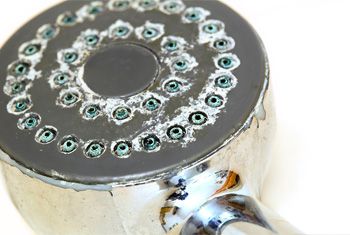 Between time at the pool, more yard work, and generally sweaty weather, summer is often the time when we have a tendency to take more showers. If your shower is getting more than its share of use, it’s a good idea to make sure all its parts are performing properly.
Between time at the pool, more yard work, and generally sweaty weather, summer is often the time when we have a tendency to take more showers. If your shower is getting more than its share of use, it’s a good idea to make sure all its parts are performing properly.
Mineral deposits are caused by water passing through a shower head, then drying up. Over time, these mineral deposits can build up and cause nozzles to push out water in numerous directions. This misdirected water can cause damage to floors, walls, or surfaces near the shower costing you time and money. The deposits also can cause a reduction in water flow, which frustrates the bather.
Hard water is water that has a high mineral content, formed when water percolates through deposits of limestone and chalk, which are largely made up of calcium and magnesium carbonates. The more calcium and magnesium dissolved in the water, the harder the water becomes. For this reason, certain cities and counties within the same state can have varying degrees of water hardness. It is common for homes that have a well as the water source, but in some cities and townships, water can remain hard even after it is treated at a water treatment plant.
In order for water to flow freely, you need to maintain a clean shower head. Here are some tips to keep yours in top condition:
- Clean the nozzles – Mineral buildup can accumulate on a nozzle. You can try clearing buildup with a rag, gently clean the nozzle with a scrubber, or by using a toothbrush.
- Use vinegar to clean the shower head – You can either leave the shower head attached to the pipe or take the shower head apart to soak it in vinegar. When leaving it attached, fill a small plastic bag with vinegar and wrap it around the shower head with a rubber band. Keep the bag on it for a few hours for cleaning to persist. Take the bag off and run water to clear away the vinegar. Taking the shower head apart is sometimes easier and allows for a more thorough cleaning. Once apart, soak all the pieces in vinegar for several hours, then re-attach it and run water through it to clear away the vinegar. Chemicals or other harsh liquids are not recommended for cleaning a shower head or any of its parts.
- Check gaskets for leaks and lime buildup – Well water or hard water can cause clogs and leaks in a shower head and also leave brown spots on glass or ceramic surfaces. Rinse these areas with a half-water/half-vinegar solution, and clear off areas of buildup.
- Check the filter screen for dirt and other debris – The filter screen is located where the pipe attaches to the shower head. Once you detach the shower head, remove the screen with tweezers or needle-nose pliers. Run the filter under water to remove any debris or mineral buildup. You may need to soak it in vinegar for a few minutes or use a toothbrush to clear away buildup or debris.
- Switch to a more efficient shower head to prevent buildup and clogging – Changing from a 2.5 gallons-per-minute shower head to a 1.5 gallons-per-minute head could save 10 gallons of water for each 10-minute shower. For the average family of four, this saves 1,200 gallons of heated water per month and will be a great savings by the end of the year.
